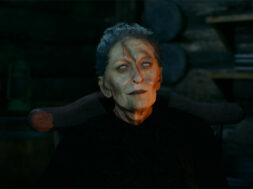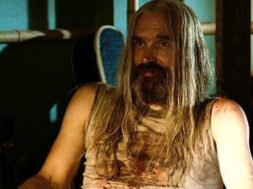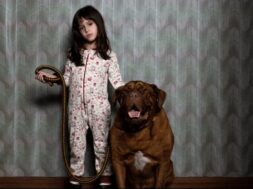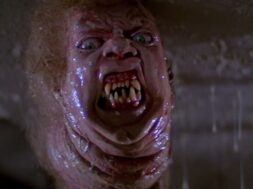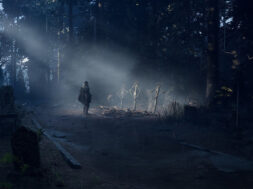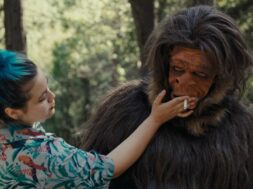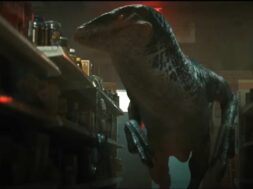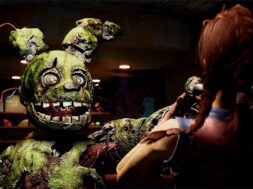
Craig Zahler follows up his FANGORIA Chainsaw Award-winning BONE TOMAHAWK with his second feature, BRAWL IN CELL BLOCK 99, starring Vince Vaughn, Jennifer Carpenter, Marc Blucas, Udo Kier and Don Johnson.
In his latest, ex-boxer Vaughn loses his job and descends into crime. While he is incarcerated, a drug lord kidnaps his pregnant wife and threatens to have his abortionist sever his daughter’s limbs and deliver her still alive. To keep his family safe on the outside, Vaughn is forced to commit acts deep inside the maximum-security prison that turn it into a charnel house.
In a possible foretaste of Zahler’s next film, DRAGGED ACROSS CONCRETE—a police brutality thriller starring Vaughn alongside his HACKSAW RIDGE director Mel Gibson—an inmate is dragged facedown across a cement cellblock floor. Maybe underneath all that concrete is lurking FLESH BENEATH THE CONCRETE, the microbudget “gore movie” he told 13th Floor he envisioned as “NC-17 (or perhaps NC-35?).” However at the moment the violence in BRAWL serves a different purpose.
Zahler told Birth.Movies.Death. that it was supposed to feel “traumatic” in BONE, whereas in BRAWL it is meant to be “cathartic.” Yet as he said to CineVue, “I spend as much time working on the drama aspects of the story as I do the extreme violence,” which explains his comparisons of BRAWL to both RIKI-OH: THE STORY OF RICKY and John Cassavetes.
As a novelist, Zahler has worked in most every genre—science fiction with CORPUS CHROME, INC.; crime with MEAN BUSINESS ON NORTH GANSON STREET; and Westerns with WRAITHS OF THE BROKEN LAND (optioned by Ridley Scott)—before entering filmmaking with the screenplay for ASYLUM BLACKOUT (also known as THE INCIDENT). Recently he scripted the upcoming reboot PUPPET MASTER: THE LITTLEST REICH, and only this year wrote an audiobook thriller THE NARROW CAVES. Next month comes his Gothic fairy-tale novel HUG CHICKENPENNY: THE PANEGYRIC OF AN ANOMALOUS CHILD that earned a blurb from Clive Barker.
One future film project listed on Zahler’s home page is FURY OF THE STRONG MAN, a title that could easily describe BRAWL. For now, the self-labelled “child of FANGORIA” offers this site the exclusive scoop on his new film, arriving on Blu-ray and DVD on December 26 and streaming at Amazon Prime on December 31.
FANGORIA: Prison films are almost a subgenre of crime—BIRDMAN OF ALCATRAZ, THE SHAWSHANK REDEMPTION, CAGED HEAT, and in recent years the prison setting has extended to cable dramas, ORANGE IS THE NEW BLACK and OZ. As a man of strong opinions, can you single any out for praise or scorn?
CRAIG ZAHLER: I haven’t seen that much contemporary prison stuff. I don’t like SHAWSHANK REDEMPTION. I always felt that that movie hid the lack of depth with the characterization, with the plot twist… I know that that is a beloved movie—I think it’s one of the highest ranked, if not the highest ranked, movies on IMDb—but I just always felt that there was a gimmick there and a lack of depth and that it was just heavy-handed and overwrought and not emotional (though it really wanted to be), and it had the score right there to let you know how emotional it should be. So yeah, not a fan of that.
I haven’t seen ORANGE IS THE NEW BLACK. Probably the last prison piece I saw that I really enjoyed was CHOPPER, directed by Andrew Dominik, all of whose movies I enjoy, and there’s a lot of good stuff in that one. So that’s what I would recommend.
OZ I thought was interesting. I watched a season of it and there was stuff I liked in there, and stuff I didn’t, but I didn’t think it was interesting enough that I wanted to continue with the experience, but I was happy to have watched a full season of it. Some of the performances are really strong, in particular J. K. Simmons, but kind of the experimental nature of the prison, to me, seemed a little bit more set up for convenience of shooting than a concept I wanted to see explored in too much detail.
But, yeah, there was some memorable stuff in there and I wouldn’t be surprised if it got better from there on out as the first season, like a lot of shows, are just finding their legs.
FANGORIA: As a novelist, any literature from the prison “subgenre,” past or present, that you can recommend to BRAWL IN CELL BLOCK 99 audiences?
ZAHLER: I’ve seen a couple of people mention Edward Bunker in reviews of BRAWL IN CELL BLOCK 99, so I’m interested to check out his books. They looked like they might be the kinds of things that I would enjoy. But I’ve not read much in the way of prison books.
FANGORIA: The flap copy for your novel A CONGREGATION OF JACKALS says your Westerns “share [your] fascination with revenge, betrayal and extreme violence in the defense of innocence,” which sounds like a description of BRAWL IN CELL BLOCK 99. Is this an accurate articulation of your themes?
ZAHLER: I mean, that’s an accurate distillation down to a core driving force of these pieces. But in my movies and books, I usually try and have a bunch of different viewpoints so there’s a driving character who’s carrying these pieces forward. In BONE TOMAHAWK, you had all those—Arthur O’Dwyer’s wife was missing and he’s going after her. In BRAWL IN CELL BLOCK 99 you have all the stuff that’s going on with Bradley [Vaughn], so for a good chunk of the piece, what’s driving him is just the desire to have a better life, and then he’s in a different situation and it more closely resembles that description. That the essential thing that’s driving the plot.
But there are always other elements at play in terms of characterization and themes and a conflict that kind of go beyond that. Certainly if we want to boil it down to a sentence, that one can be applied to both of those, A CONGREGATION OF JACKALS, WRAITHS OF THE BROKEN LAND… Less so my book MEAN BUSINESS ON NORTH GANSON STREET and not at all my book CORPUS CHROME, INC., nor my upcoming novel HUG CHICKENPENNY: THE PANEGYRIC OF AN ANOMALOUS CHILD.
FANGORIA: Nic Pizzolatto cast Vaughn in TRUE DETECTIVE to “show people stuff from Vince Vaughn they hadn’t seen before—the Vince Vaughn they always wanted, without knowing it,” then you said almost the same: “This is a Vince Vaughn you’ve never seen before.” What did you think about TRUE DETECTIVE and Vaughn’s work there? (It was very different from both BRAWL and his previous comedic roles.)
ZAHLER: I actually didn’t watch the second season, so I can’t draw a comparison between Vince’s work in TRUE DETECTIVE and what he did in my picture. I’ve heard from people that he was a standout in it. Probably at some point I’ll check it out.
I’ve just always believed in Vince as a dramatic actor, and all of my expectations were exceeded by him very, very quickly when I got the chance to work with him. Immediately in the first rehearsal I saw that this was somebody who had a tremendous amount of emotional access and a lot of range and was very willing to put himself out there.
FANGORIA: BONE TOMAHAWK had key makeup artist Hugo Villasenor for some trademark scenes of memorable savagery, so with all the bone-breaking and skull-crushing in BRAWL, who is in that seat this time around, and why him?
ZAHLER: We had a few people. In terms of Hugo Villasenor’s work, I’m demanding a lot of people on set, in that department, because I like to do everything with practical effects. And you kind of see what you get on the day, in terms of getting these gore gags and all of that sort of stuff, and then figure if you have enough or if you need to pick up some more of it, because I’m not fixing things in post in terms of doing stuff digitally. So there are a lot of people involved.
FANGORIA: You anticipated the next question: Practical over digital, is that better or worse for the budget? But I guess it depends.
ZAHLER: Yeah, it does. Doing stuff practically is probably more expensive overall for these kinds of things because anyone can just slap in some digital effects, but you can tell and—
FANGORIA: I can.
ZAHLER: Yeah, like a show like THE WALKING DEAD, or a $100 million action movie, you can tell that it’s CG. And so my personal opinion is not to think that my two or four or $13 million movie is going to miraculously have better digital effects than you’ll find in hundred and $150 million movies.
And knowing that, this is the reason that I shoot all of the stuff practically, because if you see a practical effect and it doesn’t quite work and it looked a little rubbery, at least something was there. And if you do all those effects after the fact, and you do them digitally and it doesn’t look quite right, then it’s a bunch of pixels and it doesn’t feel like anything was there. So I would rather it fall a little short in the practical category than that it looks like it was manufactured in the computer and it just feels like you’re not looking at anything.
FANGORIA: And sound design plays a potent part…
ZAHLER: Especially in this film.
FANGORIA: Can you talk about who was responsible for this, especially since you had a minimal score? To what extent is this individual, or individuals, taking their cue from your “philosophy of style”?
ZAHLER: Dan Brennan [re-recording mixer], and Craig Kyllonen [supervising sound editor/sound effects editor]. They’re the people I used on BONE TOMAHAWK and they’re terrific guys and I’m a hundred percent happy with them. We have a really good time in the mix room. I come in with a lot of very specific ideas and these guys have great ears.
It was a kind of thing where they retained a lot of the different things I was looking for, and asking for, in the first movie. To get really specific on the level of detail, there’s a moment where Samantha (Lili Simmons) winks at a Sheriff Hunt (Kurt Russell) in the cave at the end of BONE TOMAHAWK, and I wanted a little sound effect there that would draw the eye a little bit more towards her eye. And also in coloring, I brightened the white of her eye. It’s very subtle, both the sound effects and the coloring. But there were things that… I wanted to make sure that the audience looked at the right thing and noticed the wink.
So when we were doing BRAWL IN CELL BLOCK 99, there’s a moment where Bradley winks at Lauren [Jennifer Carpenter] when they’re in a police station, and we’re mixing that, they said, “Oh, you want us to use the same little wink sound effects that we used in BONE TOMAHAWK?” And so there was like about a two year gap that they retained this level of detail, which was fantastic. And they bring in a lot of their own ideas, and at the same time I’m there for that process.
And it’s a good process, but a very, very detailed one, and it’s one where you can bring these things out, and having less music means there’s more space in the mix to bring these sounds out. I’m there, I think, more than most directors, or possibly any director is there, for the mix just in terms of bringing in all the little details and stuff like that.
These are great, really talented guys, and I remember when we finished mixing BRAWL—they work at a house that does a lot of big movies and Scorsese movies come out of there and, you know, a lot of big pictures—and BRAWL IN CELL BLOCK 99 was, I believe, the loudest movie that had come out, which is interesting because there’s not a lot of music. It’s not blasting you, but it’s partially because it’s so dynamic and there are all these quiet scenes when you get into a loud explosive scene of just bones breaking and stuff like that, it really resonates in a different way.
FANGORIA: In your interview at bare•bones, you wondered aloud what publishing house might, with the success of your first feature film, pick up your out-of-print novel A CONGREGATION OF JACKALS, and now Raw Dog Screaming Press has republished it, and in an “Author’s Preferred Text” edition no less. What differences are there in your preferred text when compared to the original version?
ZAHLER: I had lost access to the editor’s corrected file when the original publisher [Dorchester Publishing] died, so when I wanted to get it out in print—as you know, there were like $90, $100 copies floating around of the first edition—I needed to go through the file again, and [my personal] file still had some errors, and once I opened it up I decided to just clean up the whole thing.
So it’s really sometimes removing a couple of metaphors that I find are getting a little too intrusive, a fair amount of the dialogue has been sharpened, not in any significant way, but enough so that I think that this version is ultimately better. The prose is a little crisper, the dialogue is a little sharper, but scene-by-scene characters are doing the same things that they did, and have the same journey that they did as in the original book.
